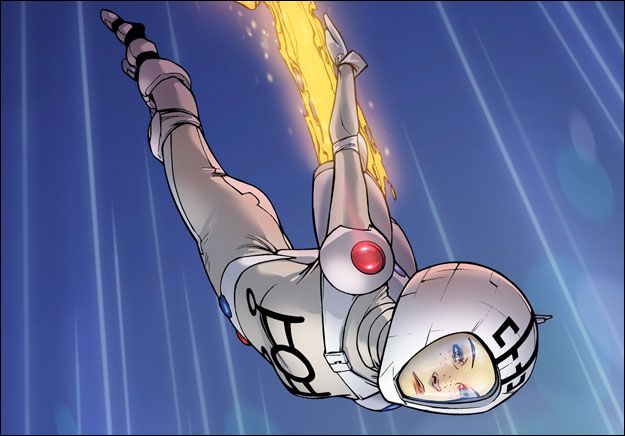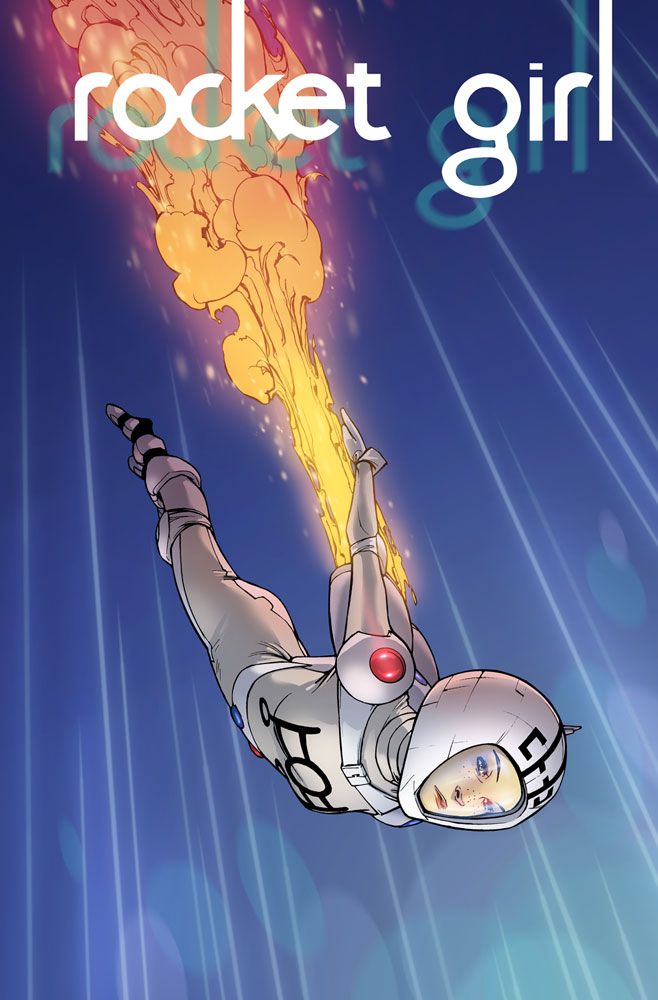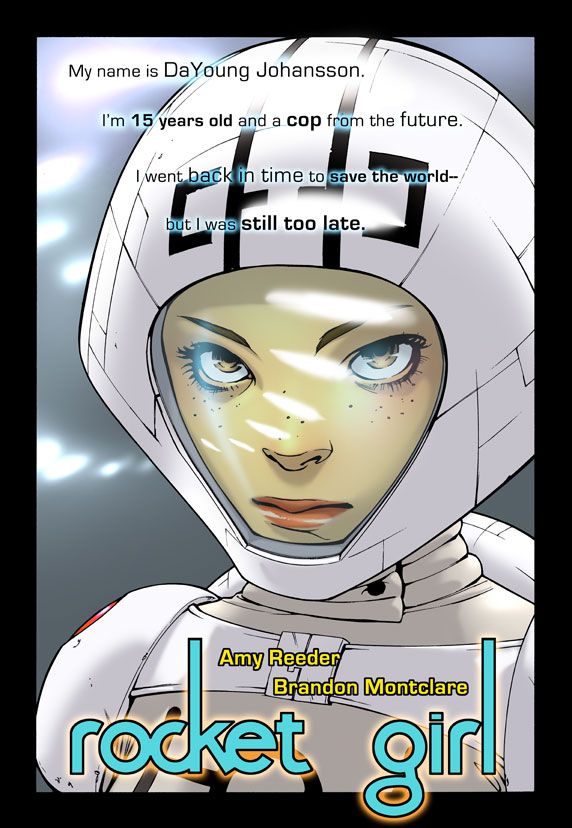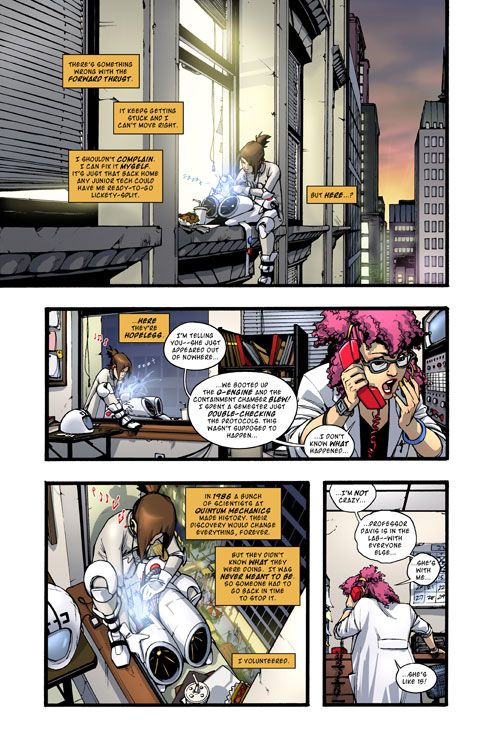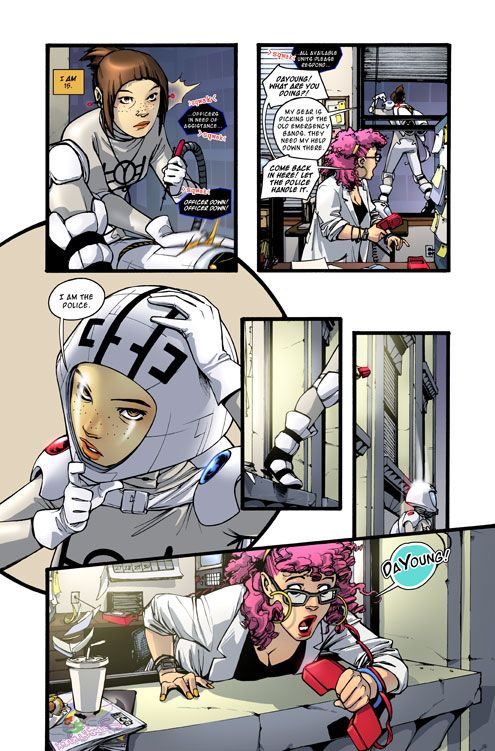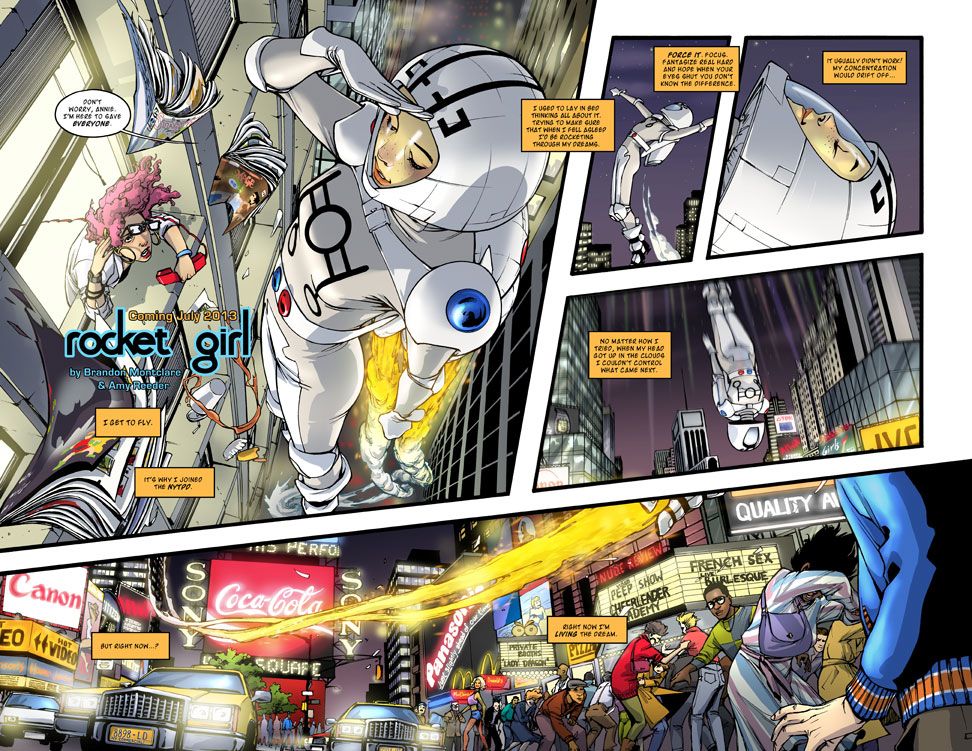After teasing fans for a few months, Amy Reeder and Brand Montclare's Rocket Girl is go for launch.
According to the Kickstarter page, which went live this morning, Rocket Girl is a "teenage cop from a high-tech future" who's sent back to 1986: "She’s investigating the Quintum Mechanics megacorporation for crimes against time. As she pieces together the clues, she discovers that the 'future' — an alternate reality version of 2013 and the place she calls home — shouldn’t exist at all."
Montclare and Reeder have been on similar flight paths since breaking into comics. They both did their time at Tokyopop before Montclare recruited Reeder to work on Madame Xanadu after he took an editorial position at Vertigo. Last year they re-teamed for a creator-owned one-shot, Halloween Eve, which they used Kickstarter to fund. And now they've returned to crowdfunding to finance the production of Rocket Girl, an ongoing series they plan to launch this fall.
I spoke with Montclare and Reeder about Rocket Girl, using Kickstarter to finance their creator-owned works and much more.
JK Parkin: "A teenage cop from a high-tech future is sent back to 1986." The word I find most intriguing in this sentence is "teenage." Can you tell us a little bit about the main character, and the circumstances that have led to teenagers working in law enforcement in this alternate reality?
Brandon Montclare: DaYoung’s age -- as well as the fact that all future police are teenagers -- is something that gets a lot of play in the series. The gist is this: To counter rampant corruption, the powers that be in DaYoung’s timeline had the bright idea to appoint teenage cops. It’s not that teens are necessarily more honest, but they are more idealistic. DaYoung has a very clear sense of right and wrong because it has not been grayed by making the compromises one makes as they grow up. She’s very black and white — perfect for a cop. Someone older and wiser (and more curmudgeonly) might tell the kid she has a lot to learn. But hopefully there’s a lot we too can learn from her diligence and integrity. DaYoung’s rigidity is a source for a lot of humor -- but her earnestness also gives Amy and me the opportunity for some poignancy.
Amy Reeder: It's a little contradictory. She's a cop BECAUSE she's a teenager, but being a cop obviously forces you to grow up in some ways and forgo your childhood. She's very tough, very independent, but she can't help being a kid underneath it all. Going to the '80s is going to show her what it really means to be young -- and in some ways, that's what she's fighting for.
JK: How do people in 1986 react to someone coming back in time to tell them her unbelievable story -- much less a teenager?
Brandon: Trust is a gigantic theme in Rocket Girl. The adults in 1986 (who are in their early 20s and perhaps still themselves have a lot to learn) don’t believe her story at all. Her technology makes her future origin undeniable, but they don’t trust her story. To them, DaYoung is just a kid and her perceptions can’t be trusted; or worse, she’s making the whole thing up.
Amy: These "adults" Brandon speaks of are physics grad students -- they are the ones who manage to create a major breakthrough in science that ultimately leads to this crazy alternate future. DaYoung has gone back to stop them, and yet she forms a strong friendship with one of the students, named Annie. Their relationship is a huge focus in the story -- they should be and ARE suspicious of each other, and yet they manage to become very close.
The general '80s New York public, on the other hand, embrace DaYoung. She's become something of a hero, a strong contrast against the corrupt police force of 1980s New York.
JK: Brandon, you mention in your pitch that this is a "love letter" to 1986. That was a pretty big year for comics -- Watchmen, The Dark Knight Returns, Maus, Man of Steel, "Born Again," the Mutant Massacre, the debut of Dark Horse and, of course, the Howard the Duck film (a character you know well). Was it a coincidence you chose that particular year for Rocket Girl to go back to? Are there any comics (or anything else) from that year that influenced Rocket Girl?
Brandon: You nailed it right on the head! 1986 was chosen, specifically, as a nod to the great comics published that year. So while there were plenty of influential books printed in years before and after, the historic success of 1986 is something that inspired me. A very specific influence on DaYoung Johannson is Carrie Kelly, the female Robin from Dark Knight Returns. They’re both a little bratty and a little punk -— and neither like people telling them they’re not old enough to fight crime. And as far as the “love letter” stuff goes -— it’s a lot more than the story and influences. Amy’s art is truly a period piece —- with tons of visual call-outs to the time.
Amy: I've drawn quite a few time periods from my work on Madame Xanadu, so it's great to return to that, only this time we're settling on a decade I've lived through! Brandon may have used comics for the inspiration of having it set specifically in 1986 (in fact, I actually drew Dark Knight, Mage and Starstruck comics into that double-page spread you see), but for the '80s in general...this series draws a lot from the action and futuristic movies of that time. It was all about cops, and all about the future. And what's great is so many of these films took place in the NEAR future -- which means Blade Runner, Back to the Future II and Akira should ALL have come to pass in THIS decade. We've all talked about how "lame" our present looks compared with these movies, and Rocket Girl plays on that, big time. Her 2013 IS that future, but it’s a future that should never have been.
JK: As far as drawing the '80s go, Amy, what sort of research did you do? Were there any references or influences that were especially prominent?
Amy: I am all about the research, and am lucky enough that I've done this sort of thing enough times before. For clothing it'll be a continual process, but I glean a lot from movies, and I'll image search things I remember. I also have a Sears catalog compilation from the '80s. This is '80s New York, so that becomes even more difficult. Not everybody looks like they come from catalogs, and there are specific taxis, police cars and architecture for that time. I'm finding old school rap videos are great for everyday New York scenes.
I reconstructed Times Square in a roundabout way ... first, I went to skyscraperpage.com ... it's a site that documents all the world's skyscrapers, their height and the date they were built. They also have a map with names of the skyscrapers. So from that I figured out which buildings were made by then. Then I went to Google Maps street view so I could see how they all line up these days. And I also used any photo or video I could find from that time, to see which ads went where. Get this: Panasonic's logo in Times Square was "Always slightly ahead of our time." Perfect!
And even the future requires '80s research, because I've decided to make it an '80s-inspired future. That was mostly researched through watching '80s future movies and taking screen caps. Any time I do something period-related, I keep a really huge library of screen caps. This time that includes Robocop, Highlander, Akira, The Fifth Element (not '80s but futuristic New York), Blade Runner and Back to the Future II.
JK: The two of you have taken this approach before, using Kickstarter to raise funds for Halloween Eve. What did you learn from that experience that you've been able to apply this time around?
Amy: I'm glad we started with a one-shot to figure everything out! Overall, things went mostly how we expected them to, which I attribute to Brandon's great business and editorial sense. It was an amazing experience. But I think now we understand a little better how much extra work it is. One thing we didn't expect last year was that it would take about a month to fulfill everybody's rewards -- this includes getting extras designed and printed, and of course signing and packing and mailing everything out. That's a month where you're not generating any extra income, so it's important to figure in!
Brandon: It’s hugely regrettable that we have to offer fewer rewards to international backers — but shipping costs have skyrocketed since October, and we’ve had a few frustrating experiences with lost or damaged international packages. But mostly it’s just adjustments that we’re anticipating. Like Amy said, there’s improved efficiency that can only come with experience. But it all adds up to a lot of confidence for Rocket Girl shipping on time: we made that happen last year, and it should only be easier now.
JK: For this and for Halloween Eve, you had a publisher lined up before you went to Kickstarter (Image in the case of Halloween Eve). Some folks would ask if you have a publisher, why do you need a Kickstarter? Where does the money go that you raise via Kickstarter?
Brandon: The short answer is: Rocket Girl can’t happen without a successful Kickstarter. So in that sense, the project is dependent on backers in the spirit of crowdfunding. Amy and I explored a few different financing options, including selling off some of the rights. But ultimately we’re partnering with a publisher without any advance or guaranteed pay.
Amy: We're doing it this way because it makes doing creator-owned work affordable, which I think is great! It seems pretty universally understood that comics do not have high returns, and so making them is a real work of love. We aren't receiving any money upfront. We'll have royalties once the books are published, and that will help us keep the series going forward. So Kickstarter for us will literally kickstart us into making it all.
A small percentage of money goes to Kickstarter. A lot of it goes toward fulfilling rewards. The rest goes to Brandon and me -- mostly me because I am doing this full time -- pencils, inks, colors and letters. With Halloween Eve, we had a very successful Kickstarter. Combined with sales through Image, it netted us a good page rate. Not as much as either of us make at Marvel or DC, but it was pretty close and, most importantly, enough to live on. And the personal reward of creative freedom as well as owning the work more than makes up for the difference.
Brandon: We’re both aware of the thought out there that Kickstarter should, basically, only cover printing costs. Obviously we don’t agree with that -- and I think that debate is settling down -- but we have thought about it. Again, realistically speaking, Rocket Girl doesn’t happen without a successful Kickstarter. We try to be sensitive to the issue and appreciative of all our backers by providing fair value in the rewards. Meaning: the rewards were designed to be about what one would pay for the items at the shop. The basic $10 reward gets you the comics (signed), plus an exclusive two-sided color print, plus delivery. All that being said: the plan is to have the book available in comics shops (and digitally) — we equally appreciate the support of people who buy Rocket Girl in more traditional way when it comes out in October. We’re only expecting backers who want some of the special rewards and/or who want the behind-the-scenes experience. So we don’t feel as if it’s asking for straight patronage.
JK: One of the key differences between this project and Halloween Eve is that this is an ongoing series. How much of it do you have planned out, and once it gets going, do you have plans to return to Kickstarter for future arcs or issues?
Brandon: Creatively speaking: we have a very tight five-issue arc that opens the series. Rocket Girl is something we hope goes on forever. When Issue 6 and the second arc does come, it will be after a break of a few months -- unfortunately that’s the only way we can maintain production. As long as fans support the book, we’ll do tight arcs, probably four to five issues each -- something akin to “seasons” on television. Choosing to do a time-travel story gives us extreme flexibility. There’s an ending we’re working toward, but there’s a lot of ways we can get there!
Practically speaking: We truthfully have no plans for another Rocket Girl Kickstarter after this one. That’s why a strong launch is so important to us. That being said, we wouldn’t want to say “never.” There would have to be a good reason to use Kickstarter again, above and beyond the financing aspect. We don’t see that happening now, but Kickstarter is an amazing tool -- and here to stay -- so I wouldn’t necessarily be surprised if we thought of a new way to use it in the future.
Amy: What Brandon said! I’ll add that I’m done with issue #1, and this should launch in October. So we’re planning plenty of lead time so we can get you as much Rocket Girl as possible.
JK: In regard to the rewards, I'm curious about the "behind the scenes" experience offered at the $15 level, which is something you offered in your previous Kickstarter. How popular are these sorts of "making the sausage" rewards?
Amy: Yes, the Digital Insider reward! This is a new version of our previous Insider book: last time with Halloween Eve we came up with this idea of providing the layouts and script for anyone interested, and it was originally just going to be some photocopies stapled together. But it was such a popular option that we decided to actually upgrade it into its own square-bound book. We’re going to do an e-book this time around: It allows us to do a lot more pages of content, including all of the separate inks. And most of all, it allows for color!
Brandon: Getting a peek behind the scenes is actually something everyone gets. If you back at just $1, we’ll still be sending out a weekly update that shows some aspect of process -- as well as exclusive podcasts, Q&A and stuff like that. If you follow Amy’s amazing Tumblr, you get a taste at how thorough her thoughts are behind process; moreover, how great she is at teaching and communicating. I try to keep up with my parts of the Insider rewards. It’s very important that backers feel like they’re making this book along with us. The response during Halloween Eve was phenomenal — tons of professionals, aspiring creators and just hardcore fans wanted to know how we made that book. We’re proud that a third of Halloween Eve Kickstarter supporters were female -- and an even higher percentage were backers for the behind-the-scenes rewards.
JK: In regards to your own process, you two obviously like working together. How do the two of you collaborate, and where did this particular idea come from?
Amy: Rocket Girl actually started with the name. We had been trying to come up with the right story to do next, and had five or six possibilities, but nothing felt like THE STORY we HAD to do. On one occasion Brandon randomly blurted out the name "Rocket Girl," but only as a hypothetical example for something sarcastic. I can't even remember what it was. But I made him stop right there, because suddenly I wanted to draw Rocket Girl!
Brandon: I believe I said was something like, "We can’t just do a random story about someone who flies around and call it 'Rocket Girl.'" ... My point at the time, I think, was we needed to think of a story that was more contained. It couldn’t just be premised-based, like continuing monthly superhero comics. But as it turns out: we did do a book called "Rocket Girl"! And it is about someone who flies around fighting crime and helping people — but ultimately we made up an ending and a character arc to get us there.
Amy: What's funny is, there was absolutely no plot at that point, and yet what Brandon came up with turned out to be genius. That was all him. I just knew what I wanted her costume to look like.
Brandon: Working together, in general, is pretty casual like that. We decide together what we want to do, bouncing ideas of each other. So the story gets hashed out. Then I’ll write a full script, and Amy will have all the input she wants. Then she’ll start drawing -- layouts first to flesh out my script; if I have any thoughts at that point, I share them. There’s probably a very few times where Amy basically rewrites a scene. And even fewer times where I get explicit with art direction. So we each do our own thing. Because the art requires so much more time, and because of my experience in editing and comics retail, I handle a lot of the administrative and “publishing” stuff behind the scenes. I think the success of our collaboration is simply that we’re on the same side: we find a project that excites us both and works to our strengths, and appreciate what the other brings to the table.
JK: Finally, what were the two of you doing in 1986, and if you could time travel to that year, what would you want to tell your younger selves?
Amy: I was 5 or 6, living in Colorado! When I was young I always expected to be a hugely famous singer, so I think I'd be afraid to tell my stubborn 5-year-old self anything. I wouldn't want to jinx what I've got going now. I'd just want to hang out with me and pick out my most hilarious neon '80s outfit and take me out for some ice cream. And help me graffiti my bedroom walls.
Brandon: I would have been 11 years old in the summer of 1986. I was reading a lot of comics. It was about a year before I started buying and selling books at local New York City conventions (and I’ve been employed in the comics biz in one way or another ever since). It doesn’t matter what I’d tell 11-year-old-me; there’s no way he would have listened.
For more info:

